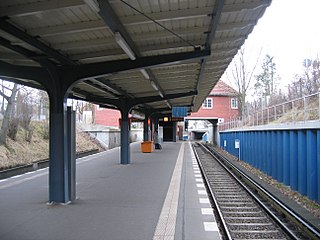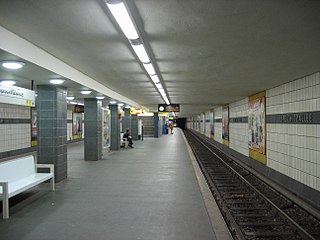

Parchimer Allee is a Berlin U-Bahn station located on the ![]() .
.
Opened in 1963 and constructed by W. Düttmann. The next station is Britz-Sud. [1]


Parchimer Allee is a Berlin U-Bahn station located on the ![]() .
.
Opened in 1963 and constructed by W. Düttmann. The next station is Britz-Sud. [1]

Paulsternstraße is a station on the Berlin U-Bahn line U7. It was opened on 1 October 1984, with the line's extension from Rohrdamm to Rathaus Spandau. Its name means "Paul Stern Street" in English, Paul Stern having been the name of a pub owner after whom a Spandau neighbourhood was named. The station's interiors are notable for the large and colorful mosaics which decorate almost all walls. All signs spell "Paulsternstrasse".

Siemensdamm is a station on the Berlin U-Bahn line U7, located in the Spandau district. It was opened on 1 October 1980 with the line's extension from Richard-Wagner-Platz to Rohrdamm. The station is named after an arterial street, which itself is named after Werner von Siemens. The company he founded, Siemens AG, has many facilities in the station's surroundings.

Hohenzollernplatz is a Berlin U-Bahn station located in the Wilmersdorf district on the line.

Berlin Heidelberger Platz is a railway station in the Wilmersdorf district of Berlin. It is served by S-Bahn lines , and and U-Bahn line .

Freie Universität (Thielplatz) is a Berlin U-Bahn station located in the Dahlem district on the . It is one of two main stations to reach the nearby Freie Universität Berlin and the Fritz Haber Institute of the Max Planck Society. It was opened on 12 October 1913 and until 1929 was the southwestern terminus of the line. In 1980, a second entrance was built. In December 2016 the station was renamed from "Thielplatz" to "Freie Universität (Thielplatz)"

Kurt-Schumacher-Platz is a station on the line of the Berlin U-Bahn. There had been a bus link outside the station connecting Berlin's Tegel International Airport to the U-Bahn network. The station was opened on 3 May 1956 and named after famous German politician Kurt Schumacher.

Biesdorf-Süd is a Berlin U-Bahn station located on the line. The station opened in 1988. After Tierpark, It comes above ground. The next station is Elsterwerdaer Platz.

Mehringdamm is a Berlin U-Bahn station located on the and the .

Westphalweg is a Berlin U-Bahn station located on the .

Wilmersdorfer Straße is a Berlin U-Bahn station located on the line.

Eisenacher Straße is a Berlin U-Bahn station located on the . R.G. Rümmler constructed this station which was opened 1971. The wall is covered with green asbestos cement panels. Since Eisenach is a city near the forest in Thuringia, which is called the green heart of Germany, Rümmler chose green as the color of this station. The next station is Kleistpark.

Grenzallee is a Berlin U-Bahn station located on the U7.

Karl-Marx-Straße is a Berlin U-Bahn station located on the line. The station was opened in 1926 as "Bergstraße," and renamed in 1946. Although Karl Marx was a hero of the socialist republic of East Germany, the station is in former West Berlin. In 1968, the station was lengthened to 105m; due to this much of its original appearance was lost. In 1993, parts of the platform fell into the rail track and the station closed for a few days while repairs were made. The station is one stop from Neukölln station, where passengers can transfer to the S-Bahn.

Lipschitzallee is a Berlin U-Bahn station located on the . This station was opened in 1970 and was planned to be named Heroldweg. However it was named Lipschitzallee. The next station is Wutzykallee.

Rathaus Reinickendorf is a Berlin U-Bahn station located on the U8. It was designed in 1994 by architect R.G.Rümmler.

Lindauer Allee is a Berlin U-Bahn station located on the in Berlin, Germany. Designed by Rainer G. Rümmler, the station opened on 24 September 1994, as part of the extension of the U8 to Wittenau. The station is tiled in green, violet, light blue and yellow with trees depicted on the walls as a reference to road's name Lindau where Lindenbaum = lime tree, Lindau is a town at Lake Constance. Mentionable is the gallery with the balustrade from where the whole station is visible. The only similar galleried view in Berlin is at the station Rathaus Spandau.

Osloer Straße is a Berlin U-Bahn station in the Gesundbrunnen district, located on the and . Like the eponymous street it is named after the City of Oslo.

Rosenthaler Platz is a Berlin U-Bahn station located on the . Opened in 1930, the station was designed by Alfred Grenander, making prominent use of orange uranium tiles.

Nauener Platz is a Berlin U-Bahn station located on the line. The square that gives it its name is named after the city of Nauen.

Berlin Rathaus Steglitz is the name of both a railway station on the Wannsee Railway and a U-Bahn station in the district of Steglitz in Berlin, Germany, which are close together. It is served by the Berlin S-Bahn, Berlin U-Bahn and numerous local bus lines.
| Preceding station | Berlin U-Bahn | Following station | ||
|---|---|---|---|---|
| Blaschkoallee towards Rathaus Spandau | | Britz-Süd towards Rudow | ||